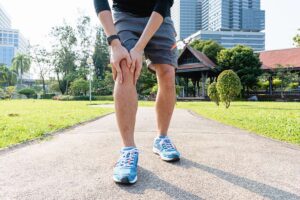 If you have pain as a result of joint problems, some of the advice you see may feel counterproductive. Physical activity is usually recommended to prevent worsening of the condition, but that same activity can be painful or even impossible as a result of your joints. The key is finding the right activities for you, the severity of your condition, and your goals. Working with an orthopedic doctor in Conyers, you can find activities that offer a balance of strengthening, relief, and moderation to help you maintain movement while you treat joint pain.
If you have pain as a result of joint problems, some of the advice you see may feel counterproductive. Physical activity is usually recommended to prevent worsening of the condition, but that same activity can be painful or even impossible as a result of your joints. The key is finding the right activities for you, the severity of your condition, and your goals. Working with an orthopedic doctor in Conyers, you can find activities that offer a balance of strengthening, relief, and moderation to help you maintain movement while you treat joint pain.
Aerobic Activities
Commonly called “cardio” workouts, aerobic activities are anything that raises your heart rate above the normal resting rate. A good target is to exercise until you notice your breathing is heavier than usual, but you can still carry on a conversation. The general recommendation for anyone is thirty minutes per day of cardio, or at least 150 minutes per week.
For those with joint problems, certain types of aerobic exercise (like running) may be difficult. Instead, find activities that don’t twist the joints or have a heavy impact on them. Aquatic aerobics are very popular as water relieves the weight that places pressure on the joints. Other options may include dancing, spin class, the elliptical, yoga, or brisk walking.
Remember to go slowly at first, then work your way up to higher intensities and durations as you begin to understand how much your joints can handle.
Balance Activities
For those with joint problems in the knee, hip, or ankle, a loss of balance can be a severe problem. Not only does this make daily activities difficult, but it can also raise the risk of falling, which can cause further joint damage. Incorporating activities that promote balance a couple of times per week can help you continue to participate in other activities safely.
These exercises can include simple exercises like standing on one foot, using balance boards and balls, or yoga and Tai Chi. Some video game consoles even offer simple, fun balance exercises.
Flexibility Training
Any physical activity requires proper stretching, and this is even more true for those suffering from joint pain. If osteoarthritis is the root of your pain and you find your joints getting stiffer over time, physical activity will also become more difficult. A routine of varying stretches after your daily exercise can help you retain your range of motion and flexibility.
For people with mobility issues or trouble moving up and down, many of these exercises can be adapted to be chair-based or performed while standing.
Strengthening Exercises
Stronger muscles can relieve pressure from the joints that causes pain. About twice per week, strengthening exercises can be done across all the major muscle groups in the body, including the chest, back, shoulders, arms, legs, and hips.
Simple body-weight resistance exercises, resistance band exercises, and weight training can be done in short repetitions to help build this muscle strength. Gyms will offer equipment for this, but they can be done simply at home with online classes and videos. Outside of this, things like yard work or shoveling snow can also work muscle groups and be part of your daily routine.
Like cardio, it is important to start small and gentle with strengthening exercises and build your skills from there.
Choosing the Right Activity for You
You should always consult with your doctor before performing any kind of exercise, especially if you have a joint condition. They will help you understand what could be harmful as opposed to helpful and how to measure your progress. You may also be able to identify modifications that can help you perform these activities based on your specific needs. For example, using knee pads may allow you to continue gardening even if your knees suffer from joint pain, or the proper orthopedic footwear can make walking and running less painful.
If you have joint pain and aren’t sure where to start, contact AICA Conyers today. Our doctors will be able to evaluate you and determine the root cause of your pain, which allows for customized treatment plans to be created. These plans will focus on treating the cause of your pain and reversing negative effects or preventing them from worsening in the future. Our doctors also have access to a tea of physical therapists, pain management specialists, chiropractors, and others who will work together to create a holistic view of your concerns and offer advice on exercise based on their collaboration. Call us today to get started!
